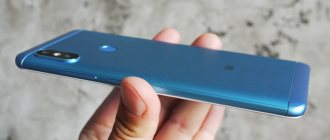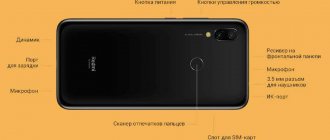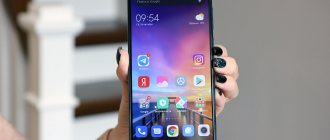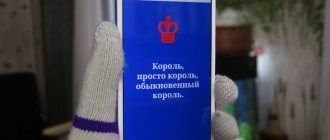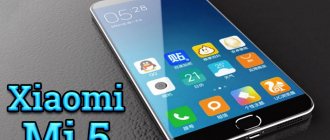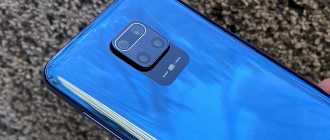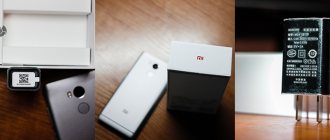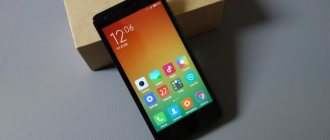In the Redmi Note 9S review, I already complained about the extreme complexity of the Xiaomi lineup, even within small subseries. This year, three Redmi Notes were released, sometimes differing in minor details.
Of the three, Redmi Note 9 stands out as a simpler and less expensive model: a 6.53-inch screen, MediaTek Helio G85 platform, a rear fingerprint scanner (that is, even externally it can be distinguished), and a 13-megapixel front camera. But the difference between Redmi Note 9S and 9 Pro is really only in the details: the Pro version received a more advanced rear camera with a 64-megapixel main module, a slightly different design in a couple of color variations (not the one we got for testing), faster charging and, perhaps most importantly, the NFC module. Well, the Pro does not have a version with 4 GB of RAM. The main features - be it the Qualcomm Snapdragon 720G platform, a 6.67-inch diagonal LCD display or a 16-megapixel front camera inscribed in the screen right in the center at the top - remained unchanged. Oddly enough, even such small changes are enough to greatly change the overall picture.
⇡#Technical characteristics
| Xiaomi Redmi Note 9 Pro | Xiaomi Redmi Note 9S | Xiaomi Redmi Note 8 Pro | realme 6 Pro | Huawei P40 lite | |
| Display | 6.67 inches, IPS, 2400 × 1080 pixels, 395 ppi; capacitive, multi-touch | 6.67 inches, IPS, 2400 × 1080 pixels, 395 ppi; capacitive, multi-touch | 6.53 inches, IPS, 2340 × 1080 pixels, 395 ppi; capacitive, multi-touch | 6.6 inches, IPS, 1080 × 2400, 399 ppi; capacitive multi-touch | 6.4 inches, IPS, 2310 × 1080 pixels (19:9), 398 ppi, capacitive multi-touch |
| Protective glass | Corning Gorilla Glass 5 | Corning Gorilla Glass 5 | Corning Gorilla Glass 5 | Corning Gorilla Glass 5 | no data |
| CPU | Qualcomm Snapdragon 720G: eight cores (2 × Kryo 465 Gold, 2.3 GHz and 6 × Kryo 465 Silver, 1.8 GHz) | Qualcomm Snapdragon 720G: eight cores (2 × Kryo 465 Gold, 2.3 GHz and 6 × Kryo 465 Silver, 1.8 GHz) | Mediatek Helio G90T: eight cores (2 × Cortex A76, 2.05 GHz + 6 × Cortex A55, 2.0 GHz) | Qualcomm Snapdragon 720G: eight cores (2 × Kryo 465 Gold, 2.3 GHz and 6 × Kryo 465 Silver, 1.8 GHz) | HiSilicon Kirin 810: eight cores (2 × Cortex-A76, 2.27 GHz + 6 × Cortex-A55, 1.88 GHz) |
| Graphics controller | Adreno 618 | Adreno 618 | ARM Mali-G56 MC4 | Adreno 618 | Mali-G52 MP6 |
| RAM | 6 GB | 4/6 GB | 6/8 GB | 8 GB | 6/8 GB |
| Flash memory | 64/128 GB | 64/128 GB | 64/128 GB | 128 GB | 128 GB |
| Connectors | USB Type-C, 3.5 mm mini-jack | USB Type-C, 3.5 mm mini-jack | USB Type-C, 3.5 mm mini-jack | USB Type-C, 3.5 mm | USB Type-C |
| Memory card slot | Yes (separate slot for microSD) | Yes (separate slot for microSD) | Yes (hybrid slot for microSD/second nano-SIM) | Yes (separate slot for microSD) | Yes (hybrid slot for nV/second nano-SIM) |
| SIM cards | 2 × nano-SIM | 2 × nano-SIM | 2 × nano-SIM | 2 × nanoSIM | 2 × nano-SIM |
| Cellular connection 2G | GSM/GPRS/EDGE 850/900/1800/1900 MHz | GSM/GPRS/EDGE 850/900/1800/1900 MHz | GSM/GPRS/EDGE 850/900/1800/1900 MHz | GSM/GPRS/EDGE 850/900/1800/1900 MHz | GSM 850/900/1800/1900 MHz |
| Cellular 3G | HSDPA 850/900/1700/1900/2100 MHz | HSDPA 850/900/1700/1900/2100 MHz | HSDPA 850/900/1900/2100 MHz | HSDPA 850/900/1700/1900/2100 MHz | HSDPA 800/850/900/1700/1900/2100 MHz |
| Cellular 4G | LTE, bands 1, 3, 4, 5, 7, 8, 20, 28, 38, 40, 41 | LTE, bands 1, 3, 4, 5, 7, 8, 20, 28, 38, 40 | LTE Cat. 6 (300/50 Mbit/s), bands 1, 3, 4, 5, 7, 8, 20, 28, 38, 40 | LTE Cat. 6 (300/150 Mbit/s), bands 1, 2, 3, 4, 5, 7, 8, 20, 28, 38, 40, 41 | LTE Cat. 13 (up to 400/75 Mbit/s), bands 1, 2, 3, 4, 5, 7, 8, 18, 19, 20, 28, 34, 38, 39, 40, 41 |
| WiFi | 802.11a/b/g/n/ac; 2.4/5 GHz | 802.11a/b/g/n/ac; 2.4/5 GHz | 802.11 a/b/g/n; 2.4/5 GHz | 802.11a/b/g/n/ac; 2.4/5 GHz | 802.11 a/b/g/n; 2.4/5 GHz |
| Bluetooth | 5.0 | 5.0 | 5.0 | 5.1 | 5.0 |
| NFC | Eat | No | Eat | Eat | Eat |
| Navigation | GPS, A-GPS, GLONASS, BeiDou, Galileo | GPS, A-GPS, GLONASS, BeiDou, Galileo | GPS, A-GPS, GLONASS, BeiDou, Galileo | GPS, A-GPS, GLONASS, BeiDou, NavIC | GPS (dual band), A-GPS, GLONASS, BeiDou, Galileo, QZSS |
| Sensors | Illumination, proximity, accelerometer/gyroscope, magnetometer (digital compass) | Illumination, proximity, accelerometer/gyroscope, magnetometer (digital compass) | Illumination, proximity, accelerometer/gyroscope, magnetometer (digital compass) | Illumination, proximity, accelerometer/gyroscope, magnetometer (digital compass) | Light, proximity, accelerometer/gyroscope, barometer, magnetometer (digital compass), color spectrum sensor |
| Fingerprint's scanner | Yes (on the side key) | Yes (on the side key) | Yes (on the rear panel) | Yes (on the side key) | Yes (on the side key) |
| Main camera | Quadruple module: 64 + 8 + 5 + 2 MP, ƒ/1.9 + ƒ/2.2 + ƒ/2.4 + ƒ/2.4, phase detection autofocus, single LED flash | Quadruple module: 48 + 8 + 5 + 2 MP, ƒ/1.8 + ƒ/2.2 + ƒ/2.4 + ƒ/2.4, phase detection autofocus, single LED flash | Quadruple module: 64 + 8 + 2 + 2 MP, ƒ/1.9 + ƒ/2.2 + ƒ/2.4 + ƒ/2.4, phase detection autofocus, dual LED flash | Quadruple module, 64 + 12 + 8 + 2 MP, ƒ/1.8 + ƒ/2.5 + ƒ/2.3 + ƒ/2.4, phase detection autofocus in the main and telephoto modules, LED flash | Quadruple module, 48 + 8 + 2 + 2 MP, ƒ/1.8 + ƒ/2.4 + ƒ/2.4 + ƒ/2.4, phase detection autofocus in the main module, LED flash |
| Front-camera | 16 MP, ƒ/2.5, without autofocus, with flash | 16 MP, ƒ/2.5, without autofocus, with flash | 20 MP, ƒ/2.0, without autofocus, with flash | 16 + 8 MP, ƒ/2.1 + ƒ/2.2, no autofocus, no flash | 16 MP, ƒ/2.0, fixed focus, no flash |
| Nutrition | Non-removable battery: 19.08 Wh (5020 mAh, 3.8 V) | Non-removable battery: 19.08 Wh (5020 mAh, 3.8 V) | Non-removable battery: 17.1 Wh (4500 mAh, 3.8 V) | Non-removable battery: 16.34 Wh (4300 mAh, 3.8 V) | Non-removable battery: 15.96 Wh (4200 mAh, 3.8 V) |
| Size | 165.8 × 76.7 × 8.8 mm | 165.8 × 76.7 × 8.8 mm | 161.4 × 76.4 × 8.8 mm | 163.8 × 75.8 × 8.9 mm | 159 × 76 × 8.7 mm |
| Weight | 209 g | 209 g | 200 g | 202 g | 183 g |
| Water and dust protection | Splash protection | Splash protection | No | Splash protection | No |
| operating system | Android 10, MIUI 11 shell | Android 10, MIUI 11 shell | Android 9.0 Pie, MIUI 10 shell | Android 9.0 Pie, realme UI shell | Android 10, EMUI 10 shell (without Google services) |
| Current price | 16,989 rubles for the 6/64 GB version, 20,950 rubles for the 6/128 GB version | 15,750 rubles for the 4/64 GB version, 16,480 rubles for the 6/128 GB version | 17,540 rubles for the 6/64 GB version, 19,350 rubles for the 6/128 GB version | 21,890 rubles | 17,780 rubles for the 6/128 GB version |
| Xiaomi Redmi Note 9 Pro – information about the filling according to the CPU-Z application | ||||
Xiaomi Redmi Note 4G Software and Specifications
This smartphone model is equipped with the Android 4.4.4 operating system, which is surprising to some users, since the version is outdated. However, basically it suits users, and the presence of the MIUI shell allows you to use the available features:
- all the necessary programs are on the phone’s desktop;
- the device is equipped with a dialer with wide functionality;
- an excellent file manager with many decent settings;
- The notification shade is also very functional.
The smartphone has proprietary applications.
The RAM in the smartphone is 2 GB, the built-in memory is 8 GB. You can increase the amount of information using an additional built-in memory card. The following micro cards are compatible with this phone model:
- microSDXC (Micro Secure Digital eXtended Capacity)
- microSDHC (Micro Secure Digital High Capacity)
- microSD (Micro Secure Digital Card, TransFlash)
The memory can be expanded up to 64 GB. The phone has 1 SIM card and a slot for an SD card. The smartphone supports Wi-Fi, Bluetooth, has a built-in GPS, radio receiver, proximity sensor, rotation orientation, gyroscope, magnetometer, and GLONASS is installed. Voice communication in the phone is good, the device works quickly and accurately via satellites, but in open space. Indoors the connection is slow. Both speakers in the smartphone provide flat, clear sound; there are no complaints in this regard. Some users have observed slowdowns when playing tunes from an SD card. Owners of this smartphone model can make video calls, chat, and social networks by first downloading the necessary applications.
⇡#Design, ergonomics and software
Xiaomi Redmi Note 9 Pro looks almost no different from Note 9S. And this “almost” is based only on the green (Tropical Green) version, in which the rear panel is painted in two different shades of green, and the flash is visually separated from the camera block. The white version or gray, as in our case, is designed exactly the same as the Note 9S.
So what should we talk about first of all about the differences from its predecessor, Redmi Note 8 Pro - has the new product gained or lost from the redesign? There is no clear answer to this question. On the one hand, the visual “nobility” has become less - the chrome edges and chiseled lines have disappeared. On the other hand, the new Redmi Note 9 has a fairly pronounced personality. If you simply confuse 9S and 9 Pro, then this entire series cannot be confused with smartphones from another manufacturer. For an era of extreme unification, the achievement is quite significant.
Xiaomi Redmi Note 9 Pro, front panel: a hole with a front camera at the top of the screen, even higher is the earpiece
Xiaomi Redmi Note 9 Pro, rear panel: quad-camera unit, flash
Separately, I would like to note the pleasant color design of the gray (Interstellar Grey) version - the glossy back shimmers, changing its color depending on the lighting; It’s difficult to perceive this smartphone as exactly gray – it’s more likely blue or cyan. However, in the case everything is more or less the same, and without a case you shouldn’t constantly use a glass gadget with curved edges, even if only at the back. Fortunately, protection made of transparent silicone is included in the kit.
Xiaomi Redmi Note 9 Pro, left side: slot for nano-SIM cards and memory cards
Xiaomi Redmi Note 9 Pro, right side: power/lock key with built-in fingerprint scanner and volume key/camera shutter key
Among the important parts of the visual code of the current Redmi Note, I will highlight the side fingerprint scanner - a previously unpopular element has sharply become fashionable this year (see realme 6 Pro, Huawei P40 lite and Honor View 30 Pro). And also an unusual block of cameras with a silver edging on two of them and a symmetrically inscribed flash, as well as a front camera in the center, and not in the corner.
Xiaomi Redmi Note 9 Pro, top edge: microphone and IR port
Xiaomi Redmi Note 9 Pro, bottom edge: mini-jack, USB Type-C port, microphone, speaker
Otherwise, the functional elements, as well as the case materials, are quite familiar: Gorilla Glass 5 on the front and back, plastic edges, a mini-jack on the bottom edge, and a USB Type-C port. The gadget, as you can easily understand from the diagonal of the screen, is very large and heavy.
It is worth mentioning the rather caustic trolling against Huawei - on the box of Redmi Note 9 Pro there is an inscription: “with easy access to the Google apps you use most” (“with easy access to your favorite Google applications”). Well, it’s a fact – which has remained so throughout the years of Xiaomi’s presence in the smartphone market. But now it’s not a sin to emphasize it, really.
The fingerprint scanner built into the side key is based on a capacitive sensor and, despite the small surface area, works well - the response is fast, the failure rate is acceptable, although the larger and fingertip-shaped scanner on the back of the Redmi Note 8 Pro worked better . On the other hand, here the scanner behaves more adequately than in the vast majority of expensive smartphones with on-screen fingerprint sensors. There are pleasant exceptions like the Xiaomi Mi 10, but by default even a small capacitive sensor is better than a large optical one. At least for now. In the settings, you can set exactly how the scanner should work - with a simple touch or with a full key press. This helps overcome the problem of side scanners so that the smartphone can be locked immediately after unlocking with a careless movement of the finger. As an addition, there is the already mentioned method of user identification by facial recognition. The front camera without additional sensors is used for this.
Screenshot gallery
View all images (24)
I have already written about the MIUI 11 shell, stretched on Android 10, several times, including recently - I refer you to the reviews of Redmi Note 9S and Mi 10, but here I will give only the main points. In this generation, MIUI, without losing its signature functionality, has become more convenient and nicer in appearance - and this is a noticeable step forward compared to the dynamics that we have seen in recent years. The shell is fast, almost devoid of strange design solutions, but not always stable (Redmi Note 9 Pro, like previous smartphones on MIUI 11 that we tested, froze in places) and has built-in advertising that cannot be completely disabled.
Cameras
The smartphone has two cameras - the main one with a 13 megapixel sensor, autofocus and flash, and the front one with 5 megapixels. Both of them demonstrate good image quality for a device in the mid-price category.
Examples of pictures taken in automatic mode:
Examples of HDR photos:
An example of shooting FullHD video:
Examples of photos taken with the front camera:
The camera app contains several shooting modes, including HDR, Macro, and Night mode. Depending on which mode you choose - simple or advanced, the number of available settings for shooting parameters and filters will differ.
⇡#Display and sound
The Xiaomi Redmi Note 9 Pro has exactly the same display as the Redmi Note 9S: 6.67 inches, IPS matrix with a resolution of 2400 × 1080 pixels and a 20:9 format. Pixel density - 395 ppi. There is no noticeable pixelation and the image is smooth. Viewing angles are free.
The screen “sandwich” is complete - there is a polarizing layer and a normal oleophobic coating.
The maximum measured brightness of the Xiaomi Redmi Note 9 Pro display was 445 cd/m2. Contrast - 1315:1.
The screen settings are not as extensive as those of the Xiaomi Mi 10, but are quite sufficient for a mid-class smartphone: there is a special reading mode with a warm screen tone, font adjustments, dark mode, even special parameters for working with the VR system. Also in the settings, you can adjust the color tone (from cold to warm), but only when automatic color rendering is activated. You can either trust the automation, which determines the color tone depending on the external lighting (the local analogue of Apple's True Tone), or choose one of two presets: saturated or standard. I measured the color rendering of the Redmi Note 9 Pro screen with these presets.
Xiaomi Redmi Note 9 Pro, gamma in standard mode. Yellow line – Redmi Note 9 Pro performance, dotted line – reference gamma
Xiaomi Redmi Note 9 Pro, color temperature in standard mode. Blue line – Redmi Note 9 Pro performance, dotted line – reference temperature
Xiaomi Redmi Note 9 Pro, color gamut in standard mode. Gray triangle – sRGB coverage, white triangle – Redmi Note 9 Pro coverage
Oddly enough, the screen behaves slightly differently than in the Redmi Note 9S - first of all, this concerns the gamma, which here is increased to 2.39, whereas in the Note 9S it was, on the contrary, lowered. Otherwise, everything is about the same - and just as good. The color temperature is close to the standard - it remains at 6,500 K with minimal fluctuations. The color space perfectly corresponds to the sRGB standard. The average DeltaE deviation on the Color Checker scale, which includes both a wide range of colors and shades of gray, was 2.60 with a standard of 3.00 - for a mobile display this is an excellent result, allowing you to correct photos directly on your smartphone without unnecessary worries about the final result.
Xiaomi Redmi Note 9 Pro, gamma in rich mode. Yellow line – Redmi Note 9 Pro performance, dotted line – reference gamma
Xiaomi Redmi Note 9 Pro, color temperature in rich mode. Blue line – Redmi Note 9 Pro performance, dotted line – reference temperature
Xiaomi Redmi Note 9 Pro, color gamut in rich mode. Gray triangle – DCI-P3 coverage, white triangle – Redmi Note 9 Pro coverage
The behavior of the Note 9 Pro's screen is even more different when the color tone is set to rich. The color gamut here is expanding - and although it does not reach the boundaries of the DCI-P3 standard, it is approaching it. The average gamma is approximately the same (2.37), but for the P3 standard this is already close to the norm (although we are focusing on Display P3 with its gamma of 2.2). The temperature is increased, but not too much - between 7,000 and 8,000 K. The average DeltaE deviation on the Color Checker scale as a result is far from normal - 5.85. The picture will not be very accurate, but it will really be rich, bright, and cold. Overall, the Redmi Note 9 Pro's screen is set up well.
In terms of sound, Redmi Note 9 Pro does not have enough stars in the sky, but at least it provides the opportunity to use wired headphones without an adapter, and wireless headphones with close to maximum comfort (there are aptX and LDAC profiles). The external speaker is monophonic, located on the bottom edge and is not blocked by your finger if you hold the gadget in a horizontal position. The sound quality through the speaker is completely ordinary, but the volume is quite enough.
Xiaomi Redmi Note is the first big smartphone from the creator of MIUI
Xiaomi decided to keep up with the general trend towards increasing the size of devices and released its version of the “shovel”. The model is called Xiaomi Redmi Note and has a screen size of 5.5 inches. I thought for quite a long time about purchasing a smartphone from Xiaomi, but as luck would have it, both mi2 and the updated version of mi2s passed me by. There is also no experience of communicating with the current flagship of the company Xiaomi mi3. My first smartphone from this company was the budget Xiaomi Red Rice on the MTK6589T chip, purchased in March as part of an aliexpress promotion. The device left a positive impression. After the release of the “big” new product from the MIUI developer, a decision was made: We must take it!
Xiaomi has achieved popularity among users due to the high quality of its products, its own modified MIUI firmware, and the minimum markup on its devices. The company's policy is to make a profit through its own services, selling themes for MIUI, and so on.
The device is made in the popular “black top, white bottom” style.
The front panel is black. At the bottom of the screen there are touch-sensitive buttons “menu”, “home” and “back” with a dim red backlight.
On top are the front camera, earpiece and proximity and light sensors. The LED indicator located to the left of the earpiece has 7 color options that can be changed in the settings.
On the right side are the volume and power keys.
At the top there is a headset jack and a hole for a second microphone.
At the bottom there is a connector for charging and synchronization with a computer and the main microphone.
The dimensions of the device are 78x154mm with a thickness of 9.4mm and a weight of almost 200 grams.
The device fits well in the hand, but for me the optimal size is 5-5.3 inches; you have to reach out to the left edge of the smartphone and move it in your hand.
The configuration of the smartphone is the most modest it can be. The manufacturer only included a charger and a charging cable.
The screen size is 5.5 inches with a resolution of 1280x720. There is no information on the official website, but apparently, the smartphone uses OGS technology. Xiaomi Redmi Note has a high-quality IPS matrix with good color reproduction. If you look at the screen from large angles, the image loses a little in brightness. In bright sunlight, the screen glares a lot, but at the right angle the image remains readable.
Multi-touch supports 10 touches. The screen feels like it has an oleophobic coating: the finger glides well, and fingerprints are easily erased.
The smartphone has the usual 8-core MTK6592 processor with a frequency of up to 1.7 GHz. During the battery test, at maximum load, the device heated up to 43 degrees, which is quite acceptable.
The amount of RAM is 2GB, which is quite enough for the period of mid-2014.
The built-in storage capacity is 8GB, of which just under 6GB is available to the user. If necessary, this volume can be increased with microSD cards up to 32GB.
A smartphone cannot be connected to a computer as a storage device. The user has a choice of USB connection: “Photo” - The smartphone is defined as a digital camera. Only the folder with photos is visible on the computer, the memory card is not visible.
“Files” - The smartphone is defined as a portable player. When you open the device from a computer, the internal memory and memory card are visible.
The device also has OTG support.
The battery capacity is an impressive 3200 mAh, which allows you to live for about two days on a single charge with average intensity of use.
Antutu Tester gave 644 points. The operating time at maximum load is just over 4 hours. Battery weight 62 grams.
The external speaker produces clear and pleasant sound without any frills, but the volume may not be enough in a noisy environment. According to the manufacturer, the smartphone is equipped with two microphones for noise reduction.
One of the advantages of Xiaomi devices is the official MIUI firmware. The convenience and popularity of MIUI is evidenced by the fact that many people port it to smartphones from other manufacturers. For me personally, the main unusual thing was the lack of a menu with installed applications. In MIUI, all installed programs appear on the desktop, and when you delete a shortcut from the desktop, the program is deleted. The smartphone supports over-the-air updates, but the downloaded update could not be installed. Perhaps due to the fact that the firmware is installed in Russian.
Settings are divided into two tabs. The first contains the basic settings that the user often accesses.
The second tab contains a complete list of smartphone settings.
The first versions of Xiaomi Note came without WCDMA support. In my smartphone this is fine, 3G works properly. It is worth noting that 3G only supports one SIM card slot in a smartphone, and I was unable to switch it programmatically.
Wi-Fi works properly, shows good speed and a reliable signal level.
The manufacturer claims to support Glonass, but in my version I could not find satellites of the Russian navigation system. Perhaps the problem is software and will be solved in the latest firmware versions.
The cold start took about a minute until all satellites were found and connected to them. During subsequent launches, satellites connect almost instantly.
I was pleased with the quality of both cameras. The 5 megapixel front camera is quite enough for Skype communication and selfies. The main camera focuses quickly and takes good pictures in good lighting.
Be careful, beard!
Front camera testing
The last two smartphones from Xiaomi left me with extremely positive impressions. Good build quality, convenient and pleasant MIUI firmware, absence of critical flaws, large selection of accessories, minimal manufacturer's markup - all this makes Xiaomi one of my favorites. I'm looking forward to updating the flagship mi3s\mi4 line.
Pros:
+ Large battery capacity + MIUI firmware from the manufacturer + High-quality display
Minuses:
— The speaker volume may not be enough in a noisy environment
useful links
Official page of the device Topic dedicated to the device on 4pda Video testing of the camera Original photos
⇡#Hardware and performance
Xiaomi Redmi Note 9 Note received the current mid-range hardware platform Qualcomm Snapdragon 720G - the same as in realme 6 Pro and, of course, in Redmi Note 9S.
The platform is built on eight cores: two Kryo 465 Gold (modified ARM Cortex-A76) with a clock frequency of 2.33 GHz and six Kryo 465 Silver (ARM Cortex-A55) with a frequency of 1.8 GHz. The Adreno 618 subsystem with an increased frequency compared to the regular Snapdragon 720 is responsible for the graphics; a Hexagon 692 signal processor is provided, which is responsible, among other things, for neural network operations. The system-on-chip is produced using an 8nm process technology.
Thanks to the larger amount of RAM (Redmi Note 9 Pro comes exclusively with 6 GB LPDDR4X), the smartphone looks preferable to its twin Note 9S in benchmarks. But, as you can see from the graphs, there is no significant increase compared to last year’s Redmi Note 8 Pro. Nevertheless, the performance reserve is enough to ensure that basic applications work easily and naturally, and any games can be launched, albeit not always at maximum.
But the Snapdragon 720G again showed a tendency towards throttling, but not critical when the frequency sags over a distance, but rather strange when it is lower at the beginning of the session. The controller does not immediately switch the cores to maximum performance mode, which is why the CPU Throttling Test produces such low results. In this case, 70% with an average performance of 142 GIPS.
The Redmi Note 9 Pro is equipped with a UFS 2.1 flash drive with a capacity of either 64 or 128 GB, with the option of expansion with a microSD memory card - and for this, a dedicated slot is used that does not overlap one of the SIM cards. This is the case when you can save money relatively easily and buy a smartphone with less memory.
⇡#Communications and wireless communications
The manufacturer does not indicate the speed of the Xiaomi Redmi Note 9 Pro LTE modem - from experience, the speed is quite decent; you still shouldn’t expect miracles from any smartphone in our highly loaded networks. The bands required for correct operation of LTE are supported. Both carrier cards of the nano-SIM standard can work with 4G.
Slot for two nano-SIM cards and one microSD card
Redmi Note 9 Pro received all the latest wireless modules: dual-band Wi-Fi 802.11a/b/g/n/ac, Bluetooth 5.0, navigation module with dual-channel GPS, A-GPS, GLONASS, BeiDou, Galileo and even an infrared port for control household appliances. And yes, this is a faithful follower of the initiative of Redmi Note 8 Pro - it has NFC, that is, using this smartphone you can pay at contactless terminals. But Redmi Note 9S did not support the trend - it does not have NFC.
Have you ordered a shovel?
It is probably possible to call a device with a 5.5-inch screen diagonal differently, but this does not change the essence of the matter. Xiaomi redmi note 4G is a classic phablet, a transition link between regular smartphones and tablets. Thanks to the efforts of many manufacturers, this form factor has become quite popular, but most buyers actually have little idea what to do with the new thing. The screen diagonal is too small for classic tablet use, and the dimensions do not allow you to use the gadget comfortably for its intended purpose - that is, to make calls. But holding a smartphone in your hand is still comfortable, and after a short period of getting used to it, you will perceive it normally, although it will still be useful to hold the new product in your hands before purchasing. The weight and size characteristics of the new product are awe-inspiring: 154 x 78.7 x 9.45 mm with a weight of almost 200 g. This, if not a record, is a more than worthy indicator. The manufacturer decided not to bother with the available colors: the only modification available is with a black top and white bottom. The case material is plastic, and dreams of metal in an inexpensive smartphone will remain so for a very long time. It is of quite high quality and externally strong, but very, very slippery, so using Xiaomi redmi note 4G in the summer heat will not be very convenient.
Xiaomi screen diagonal 5.5 inches
⇡#Camera
The key difference between the Note 9 Pro and the Note 9S, along with NFC, is the improved camera. But it’s curious that there was almost no upgrade compared to the Note 8 Pro.
At the head of the table sits the 64-megapixel Samsung ISOCELL Bright GW1 sensor, which we also saw on realme XT, for example, and on the flagship vivo NEX 3. Built according to the already traditional Quad Bayer scheme (or TetraCell - a Samsung trademark) with four subpixels, combined under one filter, it offers shooting at a default resolution of 16 megapixels with the ability to upgrade to ultra-high resolution if necessary.
| On the left is a 16-megapixel photo, on the right is a photo with a resolution of 64 megapixels | ||
As we have written more than once or twice, this scheme gives an advantage when shooting at night or when using digital zoom, where the picture, taken using all subpixels, is then “compressed” to the desired format. Shooting at a resolution of 64 megapixels (48, 108, or whatever else is available in QuadBayer cameras) does not make much sense - with ideal lighting you can get increased detail, but I would not say that the improvement is radical and worth it. At night, the 64-megapixel mode is useless. It is also worth considering that the size of each frame with a resolution of 9248 × 6936 is on average from 14 to 31 MB (in the latter case, using HDR), that is, the memory will fill up very quickly.
| From left to right: shooting at wide angle, standard focal length and 2x zoom | ||||
The sensor is quite large (1/1.7″), which made it possible to keep the size of an individual pixel unchanged compared to 48-megapixel modules - 0.8 microns. The lens lacks optical stabilization, but has a fairly high aperture ratio - f/1.9. The main camera has a phase detection autofocus system. The camera app offers both 2x “hybrid” zoom and an extended viewing angle. For this, a wide-angle module with an 8-megapixel sensor is used (sensor size is 1/4″, individual pixel size is 1.12 microns) and an f/2.2 aperture lens that does not have autofocus. It makes sense to shoot at a wide angle only in good lighting - at dusk and especially at night, this camera fails. The zoom, despite its software status, works quite confidently, including in low light conditions - and what’s more, a special night mode is applicable to it.
| On the left are pictures in the default format, on the right are with night mode activated | ||
Xiaomi Redmi Note 9 Pro allows you to get a good picture at different focal lengths during the day, but at night its capabilities are limited. Night mode, which combines multiple shots taken at different exposures, helps a little, but due to the lack of an optical stabilizer, its capabilities are limited. In its class, Redmi Note 9 Pro retains its position, but will not reach new heights relative to what Redmi Note 8 Pro has already achieved.
The new module differs from the Redmi Note 8 Pro camera in only one way - an improved camera for macro photography. Instead of a two-megapixel camera without autofocus, there is a new one installed here, with a resolution of five megapixels and autofocus, but it has a less fast lens - f/2.4. The new product is perfect for super-close-up photos. The fourth camera is needed only for portrait mode - this is a depth sensor.
| On the left is a picture without AI, on the right is with AI | ||
Algori is familiar from last year’s models or Redmi Note 9S - they increase the saturation and brightness of the frame, but do it quite carefully. Xiaomi Mi 10 has stepped forward in this regard - and it is not clear whether this is a plus or a minus for it, where the AI can overdo it. In Redmi Note 9 Pro, the AI icon can be left untouched; the intervention of neural networks here is not so significant and is almost always appropriate.
The portrait mode blurs the background quite well and allows you to achieve good results when shooting half-length and full-length portraits. But it is no longer suitable for close-ups - there is only one focal length, zoom is not available here. Accordingly, geometric distortions of the face will be very noticeable in close-ups. In portrait mode, you can adjust the degree of blur, add beauty, various preset effects, and turn on “film mode,” which produces a narrowed image with black bars around the edges and a warmer tone.
| Xiaomi Redmi Note 9 Pro camera app interface | ||||
The camera application is standard for MIUI 10. There is a watermark enabled by default indicating the smartphone model you are taking pictures with. Don't forget to turn it off in a timely manner - although you can erase it later, in the gallery.
Gallery of pictures
View all images (13)
Video recording is available in 4K resolution at up to 30 frames per second or Full HD at up to 60 frames per second. Before shooting, you can select a viewing angle (extended, standard or 2x zoom), but you cannot switch between them during the process - only use digital zoom by cropping the image with loss in quality. There is also a slow motion mode with a frequency of up to 960 frames per second (resolution - 720p). The “video clip” mode allows you to adjust the shooting speed (albeit in a smaller range), add a kaleidoscope effect or beauty with some effects. Nothing that cannot be done during post-processing, but will help the blogger save time on this very post-processing.
The front camera is not bad, but strange. The resolution is normal - 16 megapixels, but the lens has a low aperture, f/2.5. In normal lighting, you can take excellent selfies, especially since software background blur and a standard beauty feature are available. But in low light, the picture will already be inferior to what you can get on the Note 8 Pro, for example.
Photography Level
If we compare the technical characteristics of the main camera sensors, it turns out that there are absolutely no differences between gadgets in this parameter. The manufacturer decided to install four sensors with identical capabilities.
The main module is an ultra-clear 48 megapixel matrix with an f/1.75 aperture. She received a lens with six lenses and can shoot with a viewing angle of 79.4°.
It was decided to install a five-element lens in an 8 MP wide-angle module. He can take panoramic photographs with a viewing angle of 118-120°. The aperture is f/2.2.
The two-megapixel macro sensor has an f/2.4 aperture and autofocus. It can shoot at a distance of 2 to 10 centimeters, which allows you to take excellent macro photographs.
Background blur in portrait mode is achieved by a two-megapixel depth sensor with f/2.4 aperture.
The peculiarity of the eighth version is that it can work with video in 4K, like the Xiaomi Note 9 Pro smartphone. The second hero of the review supports shooting video files in 1080p at 30 frames per second.
The software settings for the devices are the same. This is artificial intelligence for determining scene parameters, timer, HDR, depth of field selection, etc.
Despite the identical resolution of the front camera (13 megapixels), there are differences in its characteristics between the phones. This concerns the aperture, which for the “nine” is f/2.25, and for the “eight” it is f/2.0.
⇡#Autonomous work
Xiaomi Redmi Note 9 Pro received the same battery as Redmi Note 9S - 19.08 Wh (5020 mAh, 3.8 V). The smartphone holds a charge throughout the day with active use: for a device with a screen of such a diagonal (6.67 inches, let me remind you) this is very good.
In our traditional test with Full HD video playback at maximum brightness, with updates and notifications turned on, Redmi Note 9 Pro lasted more than eleven hours - a good result for a smartphone with an LCD screen in itself, and an enviable increase in relation to the indicator Redmi Note 8 Pro.
The USB Type-C port is used for charging; a fast charging system with a power of 30 W is supported. As a result, it takes about an hour to completely fill the hefty battery of the Redmi Note 9 Pro. There is no wireless charging, but in my eyes, the record speed of wired charging for its class makes up for this sin.
Field tests
The performance of the new product is quite modest. Just under 22,000 points in AnTuTu, 2941 in 3DMark and 435 in Geekbench. Let's face it, the figures are not record-breaking, so those who like to ride with the breeze will not like the Xiaomi redmi note 4G. In other words, the smartphone is unlikely to suit gamers, fans of active Internet surfing, and tourists accustomed to fast GPS operation. Slippery and easily soiled plastic adds negative emotions.
The performance of Xiaomi redmi note 4G is modest - just under 22,000 points in AnTuTu Technical data of Xiaomi redmi note 4G
2941 points in 3DMark
But informal street tests were not so disastrous. The smartphone coped with its immediate responsibilities adequately: stable communication, trouble-free use of Wi-Fi, relatively mild heating and normal operation of the test set of programs. As a result, we can say that the Xiaomi redmi note 4G will not become a bestseller, but it will definitely find its buyers. Especially if they need a relatively inexpensive smartphone with a large diagonal and sufficient speed in most applications.
